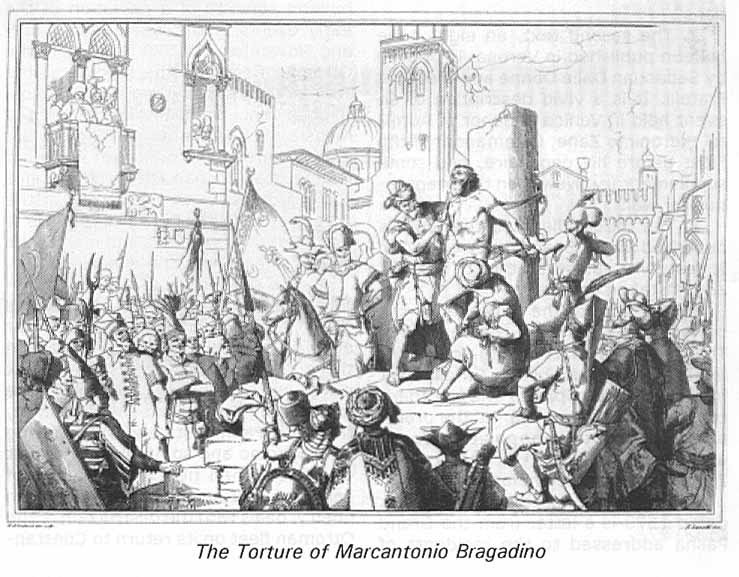 |
|
|
The War of Cyprus: AVVSI
(From Cyprus Today) |
|
|
An interesting publication of the Bank of Cyprus Cultural Foundation, AVVISI (1570-1572) The War of Cyprus, issued recently brings to light new historical material from the valuable collections of the Foundation. The volume is the last one in the series of a long-term program of publications presenting primary sources and making them widely known to the public. The nucleus of the publication is a number of news bulletins of the 16th century, a kind of "warcommuniques", published in several European cities on the subject of theWar of Cyprus in 1570 1571 between the Western Christian states and the Ottoman Empire. Of a total of nine bulletins, eight of these come from the Collection of Manuscripts and Rare Books of the Bank of Cyprus Cultural Foundation and from the private collection of Dr. .Vakis Koumarianou. Professor Catherine Papanastasiou was responsible for the compilation and elaboration of the texts with the contribution of her associate, Alexis Malliaris. |
 |
The Texts These early "journalistic" bulletins of the 16th century, precursors of the newspapers, are the evidence of the thirst of the public for information and at the same time are testimony to human psychology, the irresistible desire knowing and participating, albeit at adistance, of events without active involvement but just to relieve the monotony of life. The chief places of production were the cities of Italy, particularly Venice. This bustling port, a place of political superiority and economic achievement was the place where printing developed by leaps and bounds after the art of printing was brought to the city by Jean de Spire in 1469. Thirty years later, 150 printing presses had sprung up. The information bulletins in particular naturally benefited from the new medium, as can be confirmed by the similar activities which went on in other Italian cities (Ancona, Verona,Viterbo), in France (Paris), Germany "(Nuremberg) and Spain (Medina del Campo, Osma, Toledo). |
|
| The translations and republications of some of these to and from languages other than those in which they were first printed constitute documentation of the response and demand which these bulletins enjoyed. The sources from which the news was published were drawn and could have been written from reports or letters from ambassadors and officials or they may have been oral accounts of the events. Concerning the quality of the bulletins in the present collection, there is a differentiation to be made. Some of the bulletins confine themselves more or else exclusively to reportage on the war, the carrying out of military operations, losses etc. |  |
They also deal with the political processes and diplomatic handling involved on the opposing sides, with deliberations and plans of the allied states and other issues of a social nature. Created by the differences in mentalities and behaviors, this renders the qualitative assessment of the texts particularly interesting. Moreover, their production in several European cities points to the interest aroused by the war against the Turks in the member countries of the alliance, with the result that the publishing mechanisms for the information of the public were set in motion immediately. It is possible to conclude that there was a European network for the reproduction of the texts, a hypothesis which can be supported by the republications and translations recorded in the present AVVISI from one language to another.Methods were devised for a good distribution and circulation of the AVVISI, aiming at the rapid briefing of a demanding public. Among the clientele for the AVVISI, individuals and circles close to the centers of powers should be counted, and generally groups with interests, diplomats, scholars, military men, merchants, travelers and seamen. Indicative time units for the dissemination of news in connection with important events of the 16th century such as the fall of Nicosia on 9 September, 1570, based on official letters show that this event became known in Constantinople on 24 September, in Venice on 26 October and in Madrid on 19 December. In this case the time differences were probably a deliberate delay in passing an item of news injurious to the prestige of the Serenissima. |
|
The Avvisi The Ottomans, with the conquering momentum which marked them in the16th century, having already seized Rhodes in 1522 and Chios in 1566, turned their attention to Cyprus. Little wonder since its privileged geographical position, marking it out as a nodal point in the eastern Mediterranean had always made it the object of acquisitive interests for a long line of conquerors. 1. The first text in the collection (the one belonging to Vakis Papanastasiou) is a "threatening letter" of Sultan Selim II, son of Suleiman the Magnificent, to the "rulers of Venice". Dated 1570, it consists of three pages of writing including the title page. In the text, it is claimed in a menacing tone that the rule over Cyprus belongs "by right" to the Sultan and that God has given him the right to "destroy the faith of the Christians". |
|
| 2. The second text, an eight page bulletin published in Verona, is printed by Sebastian Daile Donne and Giovanni Fratelli. It is a vivid description of an event held in Venice in honor of Admiral Hieronimo Zane, Commander of the Fleet before his departure, and some supplementary "News" on the preparation for war. 3. The third bulletin, dated 1570 is published in the Spanish city of Osma. It deals with causes that led to the war, and mistaken estimates on the part of the Turks as to the powers of resistance of the Venetians. There is also an interesting account of the course followed by the Turkish fleet from Constantinople to the southern coast of Asia Minor as far as the promontory Chelidom, opposite Cyprus where the 200 Turkish galleys and 200,000 troops assembled. 4. The fourth bulletin in the series, dated 1570 is a letter from the Grand Pasha addressed to the residents of Cyprus, virtually identical to the one of the first text. This is followed by some military news from Venice. 5. The fifth document, published in Paris in 1570 is a French translation of an Italian original entitled "Les Dernieres Nouvelles de la Victoire des Chretiens" (Latest News of the Christian Victory) and is made up of six war communiques describing the invasion of the island by the Turkish troops. |
|
 |
6. The sixth document, an eight page bulletin consists of a narration of the early events of the war between July and November of 1570. It depicts the Ottoman fleet and the landing of theTurkish troops in the region of Paphos, their advancement and their taking of Nicosia (9 September 1570) to their encampment before the Walls of Famagusta. The narrative also contains some judgments on the causes of the defeat of the Christian allies. There is also a list of the officers and men of the allied forces who were killed. 7. The seventh text is a well structured bulletin of 16 pages. The words "From Venice, 3 January, 1572" appearon the first page and the information that the source is a letter from a Greek clergyman written in Famagusta. The first part is news from the war front, the fall of Famagusta and the suffering of Bragadino and some hints of defeat of the Ottoman fleet in the battle of Lepanto. The second text, written in poetry, deals with the destruction of the Ottoman fleet on its return to Constantinople and the lamentations of the Turks. |
|
HCS readers may wish to view other articles and releases in our permanent, extensive archives at the URL http://www.helleniccomserve.com/contents.html. |
|
 |
|
|
2000 © Hellenic Communication Service, L.L.C. All Rights Reserved. http://www.HellenicComServe.com |
|